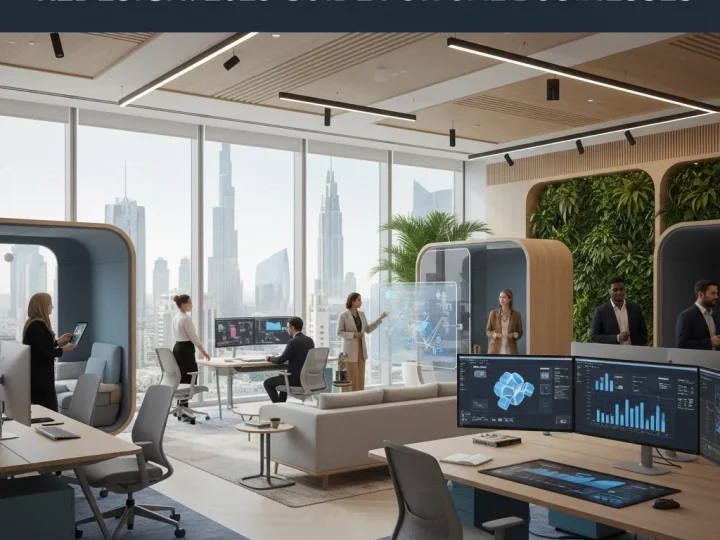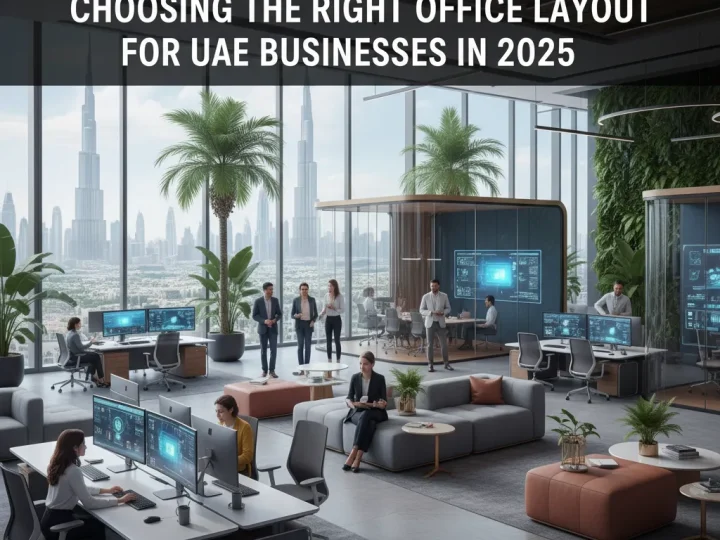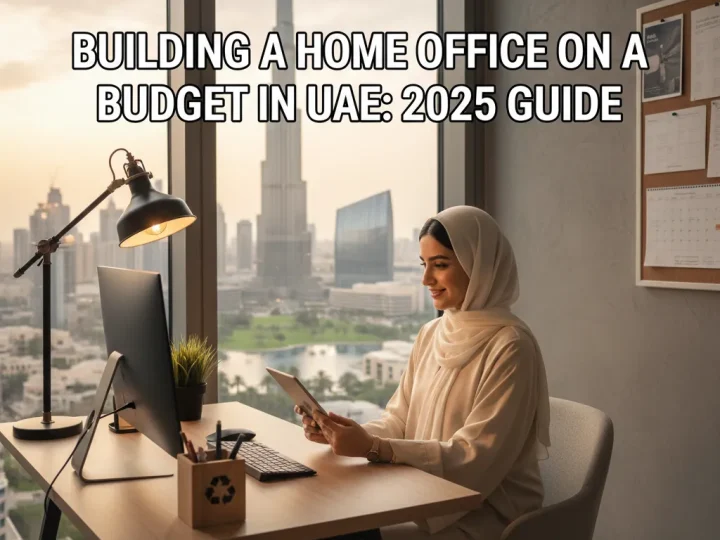

Revamping your office decor is not just about aesthetics; it’s a smart strategy for enhancing productivity. A recent survey reveals that 66% of companies expect employees to be in the office three or more days a week by 2025, highlighting the need for spaces that adapt to new work styles. But here’s the surprising part: simply updating your furniture won’t cut it. The real game-changer lies in how you arrange your space and incorporate personal touches. Investing in thoughtful design elements can transform your workspace into an inspiring environment that fuels creativity and collaboration.
Table of Contents
- Simple Ways To Refresh Your Office Space
- Decor Ideas For A Small Office
- Personalizing Your Office Decor
- Adding Greenery To Your Workspace
- Lighting Tips For A Better Office
Quick Summary
| Takeaway | Explanation |
|---|---|
| Reimagine Your Layout for Flexibility | Create adaptable office spaces that support various work styles by implementing free desking strategies and design zones for collaboration, focus, and relaxation. |
| Incorporate Comfort and Personality | Enhance the office environment by choosing comfortable furniture, personal decor, and natural materials, making the workspace feel more inviting and supportive of productivity. |
| Prioritize Natural and Advanced Lighting | Utilize natural light as much as possible and consider advanced lighting systems that adjust based on time and activity to boost comfort and productivity. |
Simple Ways to Refresh Your Office Space
Transforming your office environment doesn’t require a complete overhaul or massive investment. Strategic updates can breathe new life into your workspace, making it more functional, inspiring, and conducive to productivity. By focusing on key design elements and thoughtful modifications, you can create an office that motivates employees and reflects your company’s unique culture.
Reimagine Your Layout for Flexibility
Modern office design is moving away from rigid, assigned seating towards more adaptable spaces. CBRE and CoreNet Global research reveals that 66% of companies expect employees to be in the office three or more days a week by 2025. This shift demands office layouts that can easily transform to support different work styles and collaborative needs.
Consider implementing free desking strategies, where employees aren’t tied to specific workstations. This approach allows for greater flexibility, encouraging spontaneous interactions and supporting hybrid work models. Create zones that accommodate various work preferences: quiet areas for focused tasks, collaborative spaces for team projects, and comfortable lounges for informal meetings.
Incorporate Comfort and Personality
Employees are increasingly seeking office environments that feel more like home. Recent workplace trends show a strong preference for spaces that blend professional functionality with residential comfort. This means moving beyond sterile, uniform designs to create more personalized and welcoming work areas.
Start by introducing elements that soften the office atmosphere. Add comfortable seating like plush armchairs or modular sofas in meeting areas. Use warm color palettes that promote relaxation and creativity. Incorporate natural materials like wood and stone to create a more organic feel. Personal touches such as artwork, plants, and decorative accessories can transform a generic space into an environment that feels uniquely yours.
Smart Technology and Sustainable Design
Refreshing your office isn’t just about aesthetics—it’s about creating a smart, efficient workspace. Integrate technology that supports seamless collaboration and enhances employee experience. Install wireless charging stations, create tech-enabled meeting rooms with easy-to-use video conferencing equipment, and consider smart lighting systems that adjust based on natural light and time of day.
Sustainability is another crucial aspect of modern office design. Choose furniture made from recycled materials, implement energy-efficient lighting, and create recycling stations throughout the workspace. These choices not only reduce environmental impact but also demonstrate your company’s commitment to responsible business practices.
Remember, refreshing your office is an ongoing process. Regularly seek feedback from employees, observe how they interact with the space, and be willing to make incremental changes. The goal is to create an environment that supports productivity, encourages collaboration, and makes employees feel valued and inspired.
Decor Ideas for a Small Office
Designing a small office requires creativity, strategic planning, and an understanding of how space impacts productivity and well-being. Limited square footage doesn’t mean compromising on style or functionality. With thoughtful design choices, you can transform a compact workspace into an efficient, inspiring environment that maximizes every inch while maintaining a professional aesthetic.
Vertical Space and Smart Storage Solutions
Research from design experts emphasizes the importance of utilizing vertical space in small offices. Wall-mounted shelves, floating desks, and overhead storage units can dramatically increase usable workspace without cluttering your floor area. Consider installing adjustable shelving systems that can be reconfigured as your needs change, providing flexibility and adaptability.
Multi-functional furniture is key in small office environments. Look for desks with built-in storage, ottomans with hidden compartments, and modular furniture that can be easily rearranged. Invest in slim, compact furniture pieces that serve multiple purposes, such as a filing cabinet that doubles as a printer stand or a desk with integrated cable management solutions.

Lighting and Color Strategies
Lighting plays a crucial role in making a small office feel more spacious and energizing. Studies reveal that employees working near windows experience significant improvements in sleep quality and work performance. If natural light is limited, use strategic artificial lighting to create the illusion of openness.
Opt for a light, neutral color palette to make the space feel larger and more inviting. Whites, soft grays, and pale blues can visually expand the room. Use mirrors strategically to reflect light and create depth. Consider glass room dividers or translucent screens that allow light to pass through while defining different work zones.
Ergonomics and Minimalist Design
In a small office, every design choice must balance functionality with comfort. The World Green Building Council suggests that thoughtful interior design can boost employee productivity by up to 23%. Prioritize ergonomic furniture that supports proper posture and reduces physical strain, even in compact spaces.
Embrace a minimalist design approach, focusing on essential items that serve a clear purpose. Use cable management systems to reduce visual clutter, choose sleek, streamlined furniture, and implement a disciplined approach to workspace organization. Digital solutions can help reduce physical document storage, allowing you to maintain a clean, uncluttered environment.
Remember that personalization matters, even in small spaces. Select a few meaningful decorative elements that reflect your personality and inspire creativity. A carefully chosen piece of artwork, a small plant, or a motivational quote can add character without overwhelming the limited space.
Ultimately, designing a small office is about making intentional choices that maximize functionality, comfort, and aesthetic appeal. By focusing on smart storage, strategic lighting, ergonomic design, and a minimalist approach, you can create a workspace that feels both efficient and inspiring.
Personalizing Your Office Decor

Personalizing your office decor isn’t just about aesthetic appeal—it’s a strategic approach to creating a workspace that reflects your personality, boosts productivity, and enhances overall work satisfaction. A thoughtfully curated office environment can transform a generic space into a motivational sanctuary that supports your professional goals and personal well-being.
Strategic Personal Touches
University of Arizona research reveals that employees working in organized, personalized spaces experience a 15% increase in productivity compared to those in cluttered environments. This underscores the importance of carefully selecting personal items that inspire and motivate without creating distractions.
Begin by choosing meaningful decor elements that tell your professional story. Display achievements like awards, certificates, or professional photographs that remind you of past successes. Select a few carefully curated items that spark joy and motivation—a graduation memento, a quote from a professional mentor, or a small sculpture representing your career aspirations. The key is balance: personalize without overwhelming the workspace.
Biophilic Design and Natural Elements
Research demonstrates that incorporating natural elements can dramatically improve workplace well-being. An impressive 70% of professionals report that plants enhance their work environment, with 31% experiencing increased focus when surrounded by greenery.
Introduce plants that are low-maintenance and suited to office lighting conditions. Consider options like snake plants, succulents, or small pothos that require minimal care but provide significant aesthetic and psychological benefits. Choose planters that complement your office decor—ceramic for a modern look, wooden for a warmer feel, or metallic for an industrial aesthetic. Position plants strategically to create visual interest and improve air quality without cluttering your workspace.
Technology and Personal Branding
In today’s digital age, personalizing your office decor extends beyond physical items to include technological accessories and digital branding. Select tech accessories that reflect your professional identity—a sleek laptop stand, elegant charging stations, or coordinated peripheral devices in complementary colors.
Consider creating a digital backdrop for video conferences that subtly showcases your personality. This might involve a bookshelf background, an artwork display, or a minimalist setting that hints at your professional interests. Your digital workspace is an extension of your personal brand, so choose elements that communicate professionalism and creativity.
Remember that personalization is an ongoing process. Periodically review and refresh your office decor to ensure it continues to inspire and motivate you. Your workspace should evolve alongside your professional journey, serving as a dynamic reflection of your growth, achievements, and aspirations.
Ultimately, the most effective office decor is deeply personal. It should make you feel comfortable, inspired, and ready to tackle professional challenges. By thoughtfully curating your environment, you create a workspace that not only looks appealing but also actively supports your productivity and emotional well-being.
Adding Greenery to Your Workspace
Bringing plants into your workspace is more than just a design trend—it’s a scientifically proven strategy to enhance workplace productivity, well-being, and overall environmental quality. Research from the University of Exeter reveals that adding plants to office environments can increase productivity by up to 15%, while simultaneously improving workers’ overall sense of well-being.
Selecting the Right Plants for Your Office
Choosing appropriate plants for your workspace requires careful consideration of your specific office environment. Low-maintenance plants that thrive in indoor conditions are ideal for professionals seeking to enhance their workspace without adding significant upkeep responsibilities. Consider options like snake plants, which purify air and tolerate low light, or succulents that require minimal watering and can survive in various office conditions.
For offices with limited natural light, opt for plants like ZZ plants, pothos, or Chinese evergreens that can survive and flourish in artificial lighting. If your workspace has ample natural light, consider more diverse options like small herb gardens, decorative ficus, or air-purifying plants like spider plants and peace lilies. Remember to consider the size of your workspace—compact plants work best in smaller offices, while larger spaces can accommodate more substantial greenery.
Benefits Beyond Aesthetics
Workplace studies demonstrate that interior greenery significantly impacts employee perception and job satisfaction. Plants do more than just beautify a space; they actively contribute to creating a healthier, more engaging work environment. They help reduce stress, improve air quality, and create a sense of connection with nature that can boost mental well-being.
Consider creating small green zones within your workspace. A dedicated plant shelf, a hanging planter near your desk, or a small desktop garden can transform your work area. These green elements not only provide visual appeal but also help absorb ambient noise, reduce electromagnetic radiation from electronic devices, and improve overall air quality.
Integrating Greenery into Your Design
Biophilic design research suggests that integrating natural elements goes beyond simply adding plants. It’s about creating a holistic environment that connects workers with nature. This might involve using planters that complement your office decor, incorporating natural materials like wood and stone alongside your greenery, or designing small indoor garden spaces that serve as both decorative and functional elements.
Consider the placement of your plants strategically. Position them near windows to maximize natural light, use them to create natural dividers between workspace zones, or use hanging plants to add vertical interest to your office. Some professionals even create small terrarium displays or wall-mounted plant systems that serve as living art pieces.
Maintaining your office plants doesn’t have to be complicated. Invest in self-watering planters, set reminders for plant care, and choose species that are naturally resilient. Many modern office supply stores and online retailers offer plant care kits specifically designed for workplace environments.
Ultimately, adding greenery to your workspace is an investment in both your professional environment and personal well-being. By thoughtfully incorporating plants, you create a more vibrant, healthy, and inspiring workspace that supports creativity, reduces stress, and enhances overall work performance.
Lighting Tips for a Better Office
Lighting is far more than a functional necessity in office environments—it’s a critical factor that directly influences productivity, employee well-being, and overall workplace performance. Research in Ergonomics International Journal reveals that strategic lighting can dramatically reduce eye strain and workplace discomfort, making it a crucial element of office design.
Natural Light and Workplace Productivity
Natural daylight remains the gold standard for office illumination. Studies demonstrate that access to natural light reduces eye strain by 51% and headaches by 63%, creating a more comfortable and efficient workspace. Position workstations near windows when possible, and use light, translucent window treatments that allow maximum daylight penetration while reducing glare.
If natural light is limited, invest in full-spectrum lighting that mimics natural daylight. These lighting solutions provide a balanced light spectrum that closely resembles sunlight, helping to maintain employee energy levels and circadian rhythms. Consider adjustable desk lamps with color temperature controls that allow workers to customize their lighting environment throughout the day.
Advanced Lighting Technologies
Circadian lighting systems represent the cutting edge of workplace illumination. These intelligent lighting solutions automatically adjust light intensity and color temperature to mirror natural daylight progression, potentially increasing task performance by up to 12%. Such systems help align artificial lighting with workers’ biological rhythms, promoting better focus and energy levels.
The University of Greenwich specifically highlighted the benefits of blue-enriched lighting (17,000K), which can increase mental alertness and reduce fatigue. Consider implementing these advanced lighting technologies in areas requiring high concentration, such as collaborative spaces, individual workstations, and meeting rooms.
Practical Lighting Design Strategies
Effective office lighting goes beyond simply illuminating space—it’s about creating layers of light that support various work activities. Use a combination of ambient, task, and accent lighting to create a dynamic and adaptable environment. Ambient lighting provides overall illumination, task lighting supports specific work activities, and accent lighting adds depth and visual interest.
Ergonomic considerations are crucial. Position lighting to minimize glare on computer screens, use adjustable task lighting that allows individual customization, and avoid harsh overhead fluorescent lights that can cause eye fatigue. Consider LED technologies that offer energy efficiency, low heat emission, and customizable color temperatures.
Remember that lighting is highly personal. Provide employees with individual lighting control when possible, allowing them to adjust their immediate environment to suit their preferences and tasks. Some professionals might prefer brighter, cooler light for focused work, while others might need softer, warmer tones for creative tasks.
Ultimately, thoughtful lighting design transforms an ordinary office into an environment that supports employee well-being, enhances productivity, and creates a positive, energizing workplace atmosphere. By understanding and implementing advanced lighting strategies, you can create a workspace that not only looks great but actively supports your team’s performance and comfort.
Frequently Asked Questions
What are some creative office decor ideas to boost productivity?
To boost productivity, consider reimagining your office layout for flexibility, incorporating comfort and personal touches, and utilizing smart technology and sustainable design elements. Creating adaptable workspaces that support various work styles can enhance collaboration and focus.
How can I personalize my office decor?
Personalize your office decor by adding meaningful items that reflect your personality, such as awards, motivational quotes, or small artworks. Incorporating plants and technology that align with your brand can also enhance your workspace’s character and motivational appeal.
What types of plants are best for an office environment?
Low-maintenance plants like snake plants, pothos, and ZZ plants are ideal for office settings. These plants thrive in varying light conditions and require minimal care while improving air quality and adding aesthetic value to your space.
How does lighting affect workplace productivity?
Good lighting is crucial for productivity. Natural light reduces eye strain and headaches while enhancing mood and energy levels. For limited natural light, full-spectrum and circadian lighting systems can mimic daylight, promoting better focus and overall workplace performance.
Enhance Your Office Space and Boost Productivity with SAGTCO
Transforming your office into an inspiring and productive environment isn’t just a trend—it’s a necessity. As highlighted in our article, creative office decor ideas for 2025 emphasize the significance of adaptable layouts, comfort, and personal touches. Yet, bringing these concepts to life in your workspace often poses challenges: how do you choose the right furniture that supports flexibility? How can you personalize your decor without compromising aesthetics?
At SAGTCO, we specialize in modern, customizable office solutions tailored to meet your unique corporate needs. Our comprehensive catalog features:
- Ergonomic furniture that ensures comfort while working
- Interactive systems to facilitate collaboration and enhance productivity
- Sustainable designs that reflect your commitment to the environment

Don’t settle for a mundane workspace—act now! Explore our user-friendly website at https://sagtco.com to discover how our expert consultation and innovative designs can help you reimagine your office decor. Start creating an inspiring environment that not only boosts productivity but also reflects your brand’s personality today!




